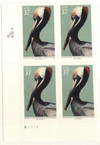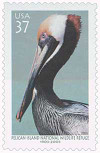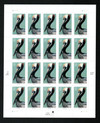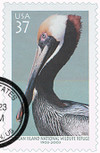
# 3774 - 2003 37c Pelican Island National Wildlife Refuge
37¢ Pelican Island National Wildlife Refuge
City: Sebastian, Florida
Quantity: 55,000,000
Printed By: Banknote Corporation of America
Printing Method: Lithographed
Perforations: Serpentine Die Cut 12 x 11.5
Color: Multicolored
Establishment Of First U.S. Wildlife Refuge
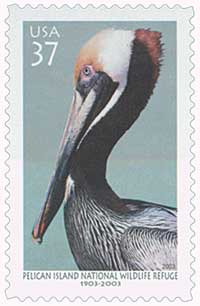
On March 14, 1903, President Theodore Roosevelt signed legislation creating Pelican Island National Wildlife Refuge, the first such protective area in America.
Just off the eastern coast of Florida lies a chain of barrier islands lined with mangrove trees. While the islands attract a wide array of shore birds, there was a small five-acre area that seemed to be a favorite for pelicans. By the mid 1800s, people in the area took note of the birds and began to hunt them for their feathers. These feathers were often uses to decorate women’s hats and were sold for very high prices.
In 1881, Paul Kroegel moved to the Indian River Lagoon and was fascinated by the pelicans and other birds. He also grew concerned about their safety after witnessing their extensive hunting. Kroegel believed the island needed protection, but there no such laws in place at the time. So he sailed to island to guard the birds from hunters himself.
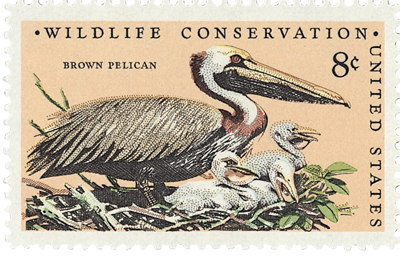
Over time naturalists grew concerned about the area too and came to visit Kroegel. Among these was Frank Chapman, curator of the American Museum of Natural History in New York. When he realized that Pelican Island was one of the last remaining Brown pelican colonies on Florida’s east coast, he knew it had to be protected.
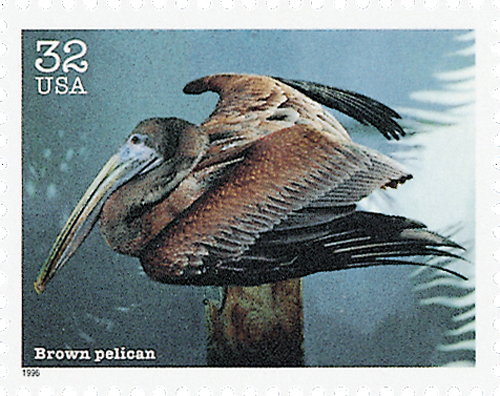
Like-minded individuals with the American Ornithologists’ Union and Florida Audubon Society then launched a campaign to protect the birds, leading to the passage of the Lacey Act, which outlawed the sale of illegally killed animals. These groups also worked to get the Audubon Model Law passed. This law outlawed plume hunting in Florida. Kroegel was then officially hired as a warden to protect the birds while others worked there to inform visitors of the plight of the pelicans.
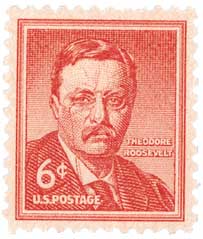
Chapman knew that more protection was needed, so he and another concerned citizen visited President Theodore Roosevelt at his New York home to plead the case for the pelicans. Roosevelt was swayed by their argument and established Pelican Island, America’s first federal bird reservation, on March 14, 1903. The refuge marked the first time the Federal government designated land specifically for the conservation of wildlife. According the act, “It is hereby ordered that Pelican Island in Indian River… is hereby reserved and set apart for the use of the Department of Agriculture as a preserve and breeding ground for native birds.”
The preserve would face its share of troubles in the coming years. At least two wardens were killed in the line of duty, leading to a national conversation about the dangers of hunting for these feathers. The Audubon Society then launched a campaign to convince people not to wear these feathers, so there would be no need to hunt for them. The refuge also faced off against fishermen who claimed that the pelicans were eating commercial fish and shouldn’t be protected. However, it was later discovered the decline was from over-fishing and not birds.
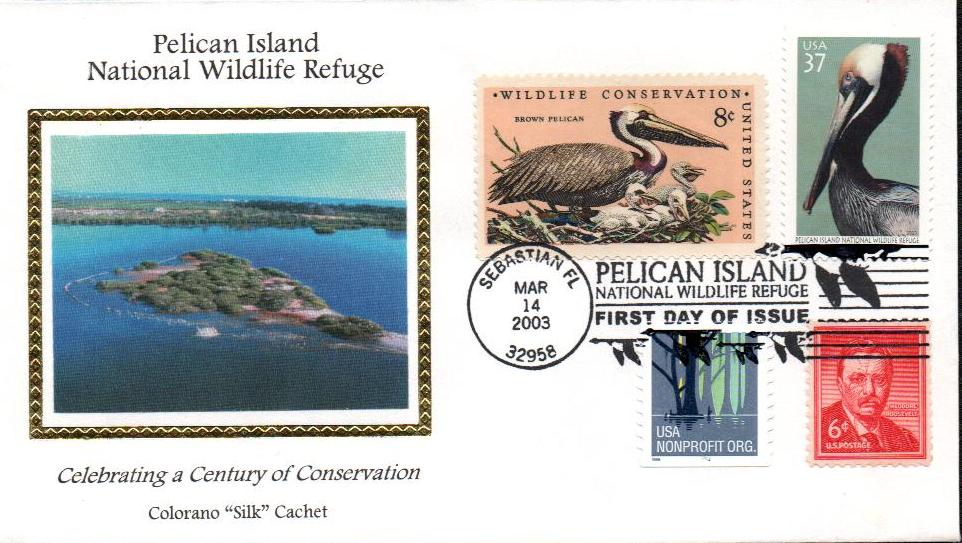
The creation of Pelican Island gave birth to the National Wildlife Refuge System. During his term in office, Roosevelt went on to establish 54 more refuges. Today, there are over 560 National Wildlife Refuges, covering over 150 million acres.
Click here to visit Pelican Island’s official website.
37¢ Pelican Island National Wildlife Refuge
City: Sebastian, Florida
Quantity: 55,000,000
Printed By: Banknote Corporation of America
Printing Method: Lithographed
Perforations: Serpentine Die Cut 12 x 11.5
Color: Multicolored
Establishment Of First U.S. Wildlife Refuge

On March 14, 1903, President Theodore Roosevelt signed legislation creating Pelican Island National Wildlife Refuge, the first such protective area in America.
Just off the eastern coast of Florida lies a chain of barrier islands lined with mangrove trees. While the islands attract a wide array of shore birds, there was a small five-acre area that seemed to be a favorite for pelicans. By the mid 1800s, people in the area took note of the birds and began to hunt them for their feathers. These feathers were often uses to decorate women’s hats and were sold for very high prices.
In 1881, Paul Kroegel moved to the Indian River Lagoon and was fascinated by the pelicans and other birds. He also grew concerned about their safety after witnessing their extensive hunting. Kroegel believed the island needed protection, but there no such laws in place at the time. So he sailed to island to guard the birds from hunters himself.

Over time naturalists grew concerned about the area too and came to visit Kroegel. Among these was Frank Chapman, curator of the American Museum of Natural History in New York. When he realized that Pelican Island was one of the last remaining Brown pelican colonies on Florida’s east coast, he knew it had to be protected.

Like-minded individuals with the American Ornithologists’ Union and Florida Audubon Society then launched a campaign to protect the birds, leading to the passage of the Lacey Act, which outlawed the sale of illegally killed animals. These groups also worked to get the Audubon Model Law passed. This law outlawed plume hunting in Florida. Kroegel was then officially hired as a warden to protect the birds while others worked there to inform visitors of the plight of the pelicans.

Chapman knew that more protection was needed, so he and another concerned citizen visited President Theodore Roosevelt at his New York home to plead the case for the pelicans. Roosevelt was swayed by their argument and established Pelican Island, America’s first federal bird reservation, on March 14, 1903. The refuge marked the first time the Federal government designated land specifically for the conservation of wildlife. According the act, “It is hereby ordered that Pelican Island in Indian River… is hereby reserved and set apart for the use of the Department of Agriculture as a preserve and breeding ground for native birds.”
The preserve would face its share of troubles in the coming years. At least two wardens were killed in the line of duty, leading to a national conversation about the dangers of hunting for these feathers. The Audubon Society then launched a campaign to convince people not to wear these feathers, so there would be no need to hunt for them. The refuge also faced off against fishermen who claimed that the pelicans were eating commercial fish and shouldn’t be protected. However, it was later discovered the decline was from over-fishing and not birds.

The creation of Pelican Island gave birth to the National Wildlife Refuge System. During his term in office, Roosevelt went on to establish 54 more refuges. Today, there are over 560 National Wildlife Refuges, covering over 150 million acres.
Click here to visit Pelican Island’s official website.









